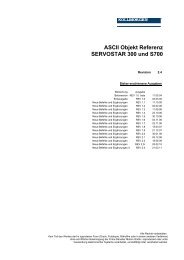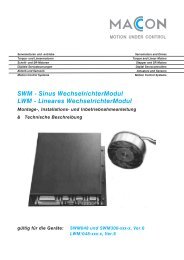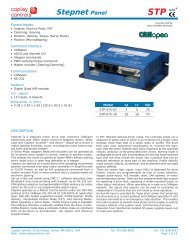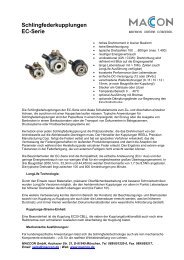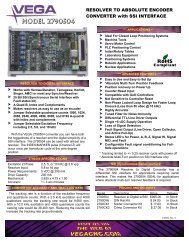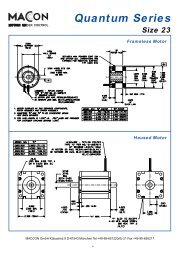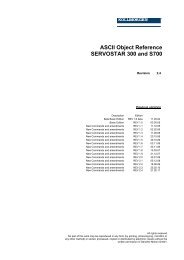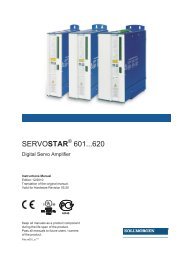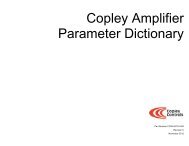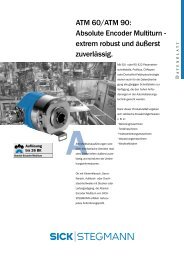CANopen Programmer's Manual - Maccon.de
CANopen Programmer's Manual - Maccon.de
CANopen Programmer's Manual - Maccon.de
Create successful ePaper yourself
Turn your PDF publications into a flip-book with our unique Google optimized e-Paper software.
9: Cyclic Synchronous Mo<strong>de</strong>s <strong>CANopen</strong> Programmer’s <strong>Manual</strong><br />
IP MOVE SEGMENT COMMAND INDEX 0X2010<br />
Type Access Units Range Map PDO Memory<br />
8 Byte array RW - - YES R<br />
Overview<br />
This object is used to send PVT segment data and buffer control commands in interpolated<br />
position mo<strong>de</strong>. This object is write only.<br />
Byte 1: Hea<strong>de</strong>r Byte<br />
The first byte of the object i<strong>de</strong>ntifies the type of information contained in the rest of the message.<br />
Among other things, it <strong>de</strong>termines whether the PVT Segment Command object operates in a PVT<br />
buffer command mo<strong>de</strong> or carries a PVT profile segment.<br />
Buffer Command Mo<strong>de</strong><br />
If the most significant bit of the hea<strong>de</strong>r byte is set to 1, then the PVT segment command object is<br />
a PVT buffer command. In this case, the command co<strong>de</strong> is located in the remaining 7 bits of the<br />
hea<strong>de</strong>r byte and should take one of the following co<strong>de</strong>s:<br />
Co<strong>de</strong> Description<br />
0 Clear the buffer and abort any move in progress.<br />
1 Pop the N most recently sent segments off the buffer. PVT profiles will continue to run as long as the buffer<br />
doesn't un<strong>de</strong>rflow. The number of segments to pop (N) is passed in the next byte (byte 1 of the message).<br />
If there are less then N segments on the buffer, this acts the same as a buffer clear except that the profile is<br />
not stopped except by un<strong>de</strong>rflow.<br />
2 Clear buffer errors. The next byte of data gives a mask of the errors to be cleared (any set bit clears the<br />
corresponding error). Error bit locations are the same as the top byte of the status value.<br />
3 Reset the segment ID co<strong>de</strong> to zero.<br />
4 No operation. Used with EtherCAT<br />
PVT Segment Mo<strong>de</strong><br />
If the most significant bit of the first byte of the message is a zero, then the message contains a<br />
segment of the PVT profile. The remaining bits of this first byte contain the following values:<br />
Bits Description<br />
0-2 Segment integrity counter. This three-bit value increases for each segment sent and is used by the amplifier to<br />
i<strong>de</strong>ntify missing profile segments. More <strong>de</strong>tails of the use of this value are provi<strong>de</strong>d below.<br />
3-6 These bits hold a buffer format co<strong>de</strong>. This co<strong>de</strong> i<strong>de</strong>ntifies how the PVT data is packed into the remaining 7<br />
bytes of the message. See the table below for <strong>de</strong>tails.<br />
7 Zero. This bit is always zero i<strong>de</strong>ntifying the message as containing PVT data.<br />
214 Copley Controls




